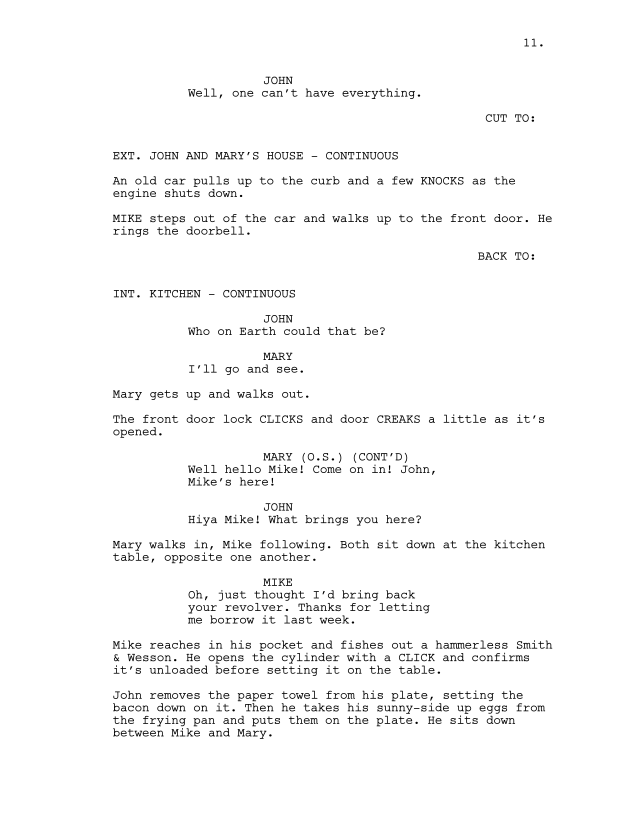3.2: Single-Column Scripts
- Page ID
- 129718
Screenplays and Narrative Scripts
Short films and feature-length films are scripted with very specific standards for style and formatting, and there are many screenwriting programs that have been developed to assist the writer with proper formatting. Final Draft is a screenwriting program with many formatting features commonly used by many screenwriters. If you are just getting started with screenwriting, a free program such as Celtx Celtxis a great way to begin writing scripts for your short films.
There are many resources you can find online to help you learn proper formatting for screenplays, including dialogue, headers, sluglines, and parentheticals. Check out the resources available on Studio Binder to help you get a better understanding of screenplay formatting.

Figure \(\PageIndex{1}\): Screenplay using the Single-Column Script format. The action/stage directions gives a description of the location and set the scene. The script shows dialogue between three characters.
Single-Camera Sitcoms
The “single-camera” sitcom has grown in popularity in the last few decades. Shows like Modern Family, Black-ish, and The Last Man on Earth are contemporary examples of sitcoms that are shot in the single-camera style of narrative films. While the “single-camera” label is misleading — such shows often use more than one single camera — the key element is that the show is shot much more like a film, without a live audience.
Single-camera sitcoms are formatted just like feature screenplays: one page of script equals roughly one minute of screen time (depending on how fast the dialogue is delivered). A broadcast-network single-camera sitcom script is usually 22 to 32 pages long, while single-camera sitcom scripts for basic and premium cable can go all the way up to 40 minutes. Television writers also take into account commercial breaks when structuring the script into acts. Most “30-minute” broadcast sitcom episodes are actually only around 22 minutes long because of ad breaks.
The main difference between the formatting of film screenplays and single-camera sitcom scripts (teleplays) is that the beginnings and ends of acts are labeled in sitcoms (such as ACT ONE and END OF ACT ONE), centered, underlined, and in caps, and new acts start on new pages.
Multi-Camera Sitcoms
Multi-camera sitcoms represent the more traditional approach to television comedy, classic sitcom programs such as The Dick Van Dyke Show, The Mary Tyler Moore Show, Three’s Company, Family Ties, Seinfeld, and Friends all use similar production techniques of shooting four camera angles on a live soundstage in front of a studio audience.
Contemporary multi-camera sitcoms like The Big Bang Theory have taken the torch from those classics. They are typically filmed in front of a live studio audience and/or have a laugh track added. The humor presented in multi-cam sitcom production is much different because of the live audience factor.
While single-camera sitcom filming can be equated to feature film styles, multi-camera sitcoms are similar to live theater. The studio acts as a stage set before an audience and the “play” is captured on multiple cameras as actors walk from one set into another, often in just one take with multiple cameras capturing the necessary angles to create an otherwise seamless experience for television.
Multi-cam sitcom scripts are formatted differently from single-camera sitcom scripts, with much less description of the characters' actions in the bulk of the scene. Typically, the scene is described at the header and dialogue follows.
Multi-camera scripts have a more technical approach in their format, which takes an otherwise 22-32 page television script and turns it into a 52-58 page script (due to spacing and formatting).


